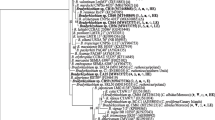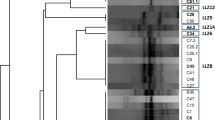Abstract
In this work we analysed different chromosomal and symbiotic markers in rhizobial strains nodulating Lupinus albus (white lupin) in several continents. Collectively the analysis of their rrs and atpD genes, and 16S-23S intergenic spacers (ITS), showed that they belong to at least four chromosomal lineages within the genus Bradyrhizobium. Most isolates from the Canary Islands (near to the African continent) grouped with some strains isolated on mainland Spain and were identified as Bradyrhizobium canariense. These strains are divided into two ITS subgroups coincident with those previously described from isolates nodulating Ornithopus. The remaining strains isolated on mainland Spain grouped with most isolates from Chile (American continent) forming a new lineage related to Bradyrhizobium japonicum. The strains BLUT2 and ISLU207 isolated from the Canary Islands and Chile, respectively, formed two new lineages phylogenetically close to different species of Bradyrhizobium depending on the marker analyzed. The analysis of the nodC gene showed that all strains nodulating L. albus belong to the biovar genistearum; nevertheless they form four different nodC lineages of which lineage C is at present exclusively formed by L. albus endosymbionts isolated from different continents.





Similar content being viewed by others
References
Altschul SF, Gish W, Miller W, Myers EW, Lipman DJ (1990) Basic local alignment search tool. J Mol Biol 215:403–410
Álvarez-Martínez ER, Valverde A, Ramírez-Bahena MH, García-Fraile P, Tejedor C, Mateos PF, Santillana N, Zúñiga D, Peix A, Velázquez E (2009) The analysis of core and symbiotic genes of rhizobia nodulating Vicia from different continents reveals their common phylogenetic origin and suggests the distribution of Rhizobium leguminosarum strains together with Vicia seeds. Arch Microbiol 191:659–668
Andam CP, Parker MA (2007) Novel alphaproteobacterial root nodule symbiont associated with Lupinus texensis. Appl Environ Microbiol 73:5687–5691
Barrera LL, Trujillo ME, Goodfellow M, García FJ, Hernández-Lucas I, Dávila G, van Berkum P, Martínez-Romero E (1997) Biodiversity of bradyrhizobia nodulating Lupinus spp. Int J Syst Bacteriol 47:1086–1091
Clapham WM (1997) Lupin development. Field Crops Res 52:283–284
Dijkstra DS, Linnemann AR, van Boekel TA (2003) Towards sustainable production of protein-rich foods: appraisal of eight crops for Western Europe. Part II: Analysis of the technological aspects of the production chain. Crit Rev Food Sci Nut 43:481–506
Erbas M, Certel M, Uslu MK (2005) Some chemical properties of white lupin seeds (Lupinus albus L.). Food Chem 89:341–345
Gaunt MW, Turner SL, Rigottier-Gois L, Lloyd-Macgilp SA, Young JWP (2001) Phylogenies of atpD and recA support the small subunit rRNA-based classification of rhizobia. Int J Syst Evol Microbiol 51:2037–2048
Iglesias O, Rivas R, García-Fraile P, Abril A, Mateos PF, Martinez-Molina E, Velázquez E (2007) Genetic characterization of fast-growing rhizobia able to nodulate Prosopis alba in North Spain. FEMS Microbiol Lett 277:210–216
Jarabo-Lorenzo A, Pérez-Galdona R, Donate-Correa J, Rivas R, Velázquez E, Hernández M, Temprano F, Martínez-Molina E, Ruiz-Argüeso T, León-Barrios M (2003) Genetic diversity of bradyrhizobial populations from diverse geographic origins that nodulate Lupinus spp. and Ornithopus spp. Syst Appl Microbiol 26:611–626
Jensen CR, Joernsgaard B, Andersen MN, Christiansen JL, Mogensen VO, Friis P, Petersen CT (2004) The effect of lupins as compared with peas and oats on the yield of the subsequent winter barley crop. Eur J Agron 20:405–418
Kalita M, Stepkowski T, Lotocka B, Malek W (2006) Phylogeny of nodulation genes and symbiotic properties of Genista tinctoria bradyrhizobia. Arch Microbiol 186:87–97
Kimura M (1980) A simple method for estimating evolutionary rates of base substitutions through comparative studies of nucleotide-sequences. J Mol Evol 16:111–120
Kuykendall LD (2005) Order VI. Rhizobiales ord. nov. In: Brenner DJ, Krieg NR, Staley JT, Garrity GM (eds) Bergey’s manual of systematic bacteriology, (The Proteobacteria), part C (The Alpha-, Beta-, Delta-, and Epsilonproteobacteria), vol 2, 2nd edn. Springer, New York, pp 324–340
Laguerre G, Nour SM, Macheret V, Sanjuan J, Drouin P, Amarger N (2001) Classification of rhizobia based on nodC and nifH gene analysis reveals a close phylogenetic relationship among Phaseolus vulgaris symbionts. Microbiology 147:981–993
Laranjo M, Alexandre A, Rivas R, Velázquez E, Young JP, Oliveira S (2009) Chickpea rhizobia symbiosis genes are highly conserved across multiple Mesorhizobium species. FEMS Microbiol Ecol 66:391–400
Lindström K, Young JPW (2009) International committee on systematics of prokaryotes; subcommittee on the taxonomy of Agrobacterium and Rhizobium: minutes of the meetings, 31 August 2008, Gent, Belgium. Int J Syst Evol Microbiol 59:921–922
Perret X, Staehelin C, Broughton WJ (2000) Molecular basis of symbiotic promiscuity. Microbiol Mol Biol Rev 64:180–201
Ramírez-Bahena MH, Peix A, Rivas R, Rodríguez-Navarro DN, Camacho M, Mateos PF, Martínez-Molina E, Willems A, Velázquez E (2009) Bradyrhizobium pachyrhizi sp. nov. and Bradyrhizobium jicamae sp. nov., isolated from effective nodules of Pachyrhizus erosus. Int J Syst Evol Microbiol 59:1929–1934
Rivas R, Willems A, Palomo JL, García-Benavides P, Mateos PF, Martínez-Molina E, Gillis M, Velázquez E (2004) Bradyrhizobium betae sp. nov., isolated from roots of Beta vulgaris affected by tumour-like deformations. Int J Syst Evol Microbiol 54:1271–1275
Rivas R, Peix A, Mateos PF, Trujillo ME, Martínez-Molina E, Velázquez E (2006) Biodiversity of populations of phosphate solubilizing rhizobia that nodulate chickpea in different Spanish soils. Plant Soil 287:23–33
Rivas R, García-Fraile P, Mateos PF, Martínez-Molina E, Velázquez E (2007a) Characterization of xylanolytic bacteria present in the bract phyllosphere of the date palm Phoenix dactylifera. Lett Appl Microbiol 44:181–187
Rivas R, Laranjo M, Velázquez E, Mateos PF, Oliveira S, Martínez-Molina E (2007b) Strains of Mesorhizobium amorphae and M. tianshanense carrying symbiotic genes of common chickpea endosymbiotic species constitute a novel biovar (ciceri) able to nodulate Cicer arietinum. Lett Appl Microbiol 44:412–418
Rivas R, Martens M, de Lajudie P, Willems A (2009) Multilocus sequence analysis of the genus Bradyrhizobium. Syst Appl Microbiol 32:101–110
Robinson KO, Beyene DA, van Berkum P, Knight-Mason R, Bhardwaj HL (2000) Variability in plant-microbe interaction between Lupinus lines and Bradyrhizobium strains. Plant Sci 159:257–264
Roche P, Maillet F, Plazanet C, Debellé F, Ferro M, Truchet G, Prome JC, Dénarié J (1996) The common nodABC genes of Rhizobium meliloti are host-range determinants. Proc Natl Acad Sci USA 93:15305–15310
Rosolem CA, Foloni JSS, Tiritan CS (2002) Root growth and nutrient accumulation in cover crops as affected by soil compaction. Soil Tillage Res 65:109–115
Safronova V, Chizhevskaya E, Bullitta S, Andronov E, Belimov A, Charles TC, Lindstrom K (2007) Presence of a novel 16S-23S rRNA gene intergenic spacer insert in Bradyrhizobium canariense strains. FEMS Microbiol Lett 269:207–212
Saitou N, Nei M (1987) A neighbour-joining method: a new method for reconstructing phylogenetic trees. Mol Biol Evol 4:406–425
Santillana N, Ramírez-Bahena MH, García-Fraile P, Velázquez E, Zúñiga D (2008) Phylogenetic diversity based on rrs, atpD, recA genes and 16S-23S intergenic sequence analyses of rhizobial strains isolated from Vicia faba and Pisum sativum in Peru. Arch Microbiol 189:239–247
Somasegaran P, Hoben HJ (1994) Handbook for rhizobia methods in legume-rhizobium technology. Springer, New York
Stepkowski T, Moulin L, Krzyzanska A, McInnes A, Law IJ, Howieson J (2005) European origin of Bradyrhizobium populations infecting lupins and serradella in soils of Western Australia and South Africa. Appl Environ Microbiol 71:7041–7052
Stepkowski T, Hughes CE, Law IJ, Markiewicz L, Gurda D, Chlebicka A, Moulin L (2007) Diversification of lupine Bradyrhizobium strains: evidence from nodulation gene trees. Appl Environ Microbiol 73:3254–3264
Tamura K, Dudley J, Nei M, Kumar S (2007) MEGA4: Molecular Evolutionary Genetics Analysis (MEGA) software version 4.0. Mol Biol Evol 24:1596–1599
Thompson JD, Gibson TJ, Plewniak F, Jeanmougin F, Higgins DG (1987) The clustalX windows interface: flexible strategies for multiple sequence alignment aided by quality analysis tools. Nucleic Acid Res 25:4876–4882
Trujillo ME, Willems A, Abril A, Planchuelo AM, Rivas R, Ludeña D, Mateos PF, Martínez-Molina E, Velázquez E (2005) Nodulation of Lupinus albus by strains of Ochrobactrum lupini sp. nov. Appl Environ Microbiol 71:1318–1327
Valverde A, Igual JM, Peix A, Cervantes E, Velázquez E (2006) Rhizobium lusitanum sp. nov. a bacterium that nodulates Phaseolus vulgaris. Int J Syst Evol Microbiol 56:2631–2637
Vincent JM (1970) The cultivation, isolation and maintenance of rhizobia. In: Vincent JM (ed) A manual for the practical study of root-nodule. Blackwell Scientific Publications, Oxford, pp 1–13
Vinuesa P, León-Barrios M, Silva C, Willems A, Jarabo-Lorenzo A, Pérez-Galdona R, Werner D, Martínez-Romero E (2005a) Bradyrhizobium canariense sp. nov., an acid-tolerant endosymbiont that nodulates endemic genistoid legumes (Papilionoideae: Genisteae) from the Canary Islands, along with Bradyrhizobium japonicum bv. genistearum, Bradyrhizobium genospecies alpha and Bradyrhizobium genospecies beta. Int J Syst Evol Microbiol 55:569–575
Vinuesa P, Silva C, Werner D, Martínez-Romero E (2005b) Population genetics and phylogenetic inference in bacterial molecular systematics: the roles of migration and recombination in Bradyrhizobium species cohesion and delineation. Mol Phylogenet Evol 34:29–54
Willems A, Munive A, de Lajudie P, Gillis M (2003) In most Bradyrhizobium groups sequence comparison of 16S-23S rDNA internal transcribed spacer regions corroborates DNA–DNA hybridizations. Syst Appl Microbiol 26:203–210
Zurdo-Piñeiro JL, García-Fraile P, Rivas R, Peix A, León-Barrios M, Willems A, Mateos PF, Martínez-Molina E, Velázquez E, van Berkum P (2009) Rhizobia from Lanzarote, the Canary Islands, that nodulate Phaseolus vulgaris have characteristics in common with Sinorhizobium meliloti isolates from mainland Spain. Appl Environ Microbiol 75:2354–2359
Acknowledgment
This work was supported by the Regional Government of Castilla y León (Grants GR49 and CSI04A06) and partially by Grant BOS2003-05858 from the Ministerio de Ciencia y Tecnología of the Spanish Government. A. Valverde was supported by a postdoctoral JAE-Doc (CSIC) contract and R. Rivas by a postdoctoral contract of “Ramón y Cajal” program.
Author information
Authors and Affiliations
Corresponding author
Rights and permissions
About this article
Cite this article
Velázquez, E., Valverde, A., Rivas, R. et al. Strains nodulating Lupinus albus on different continents belong to several new chromosomal and symbiotic lineages within Bradyrhizobium . Antonie van Leeuwenhoek 97, 363–376 (2010). https://doi.org/10.1007/s10482-010-9415-7
Received:
Accepted:
Published:
Issue Date:
DOI: https://doi.org/10.1007/s10482-010-9415-7




